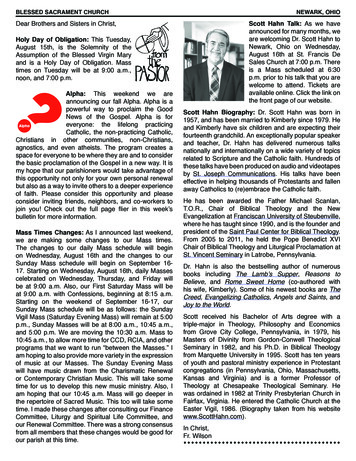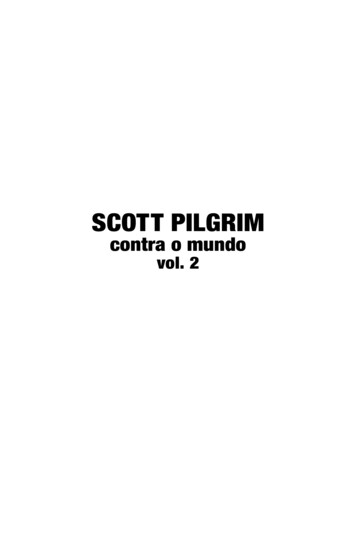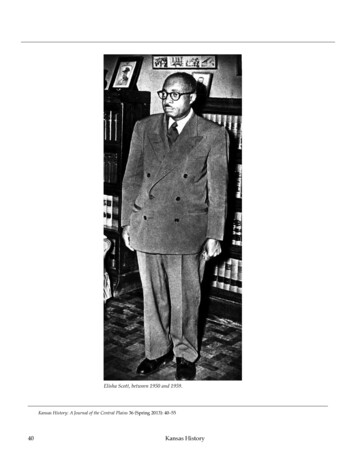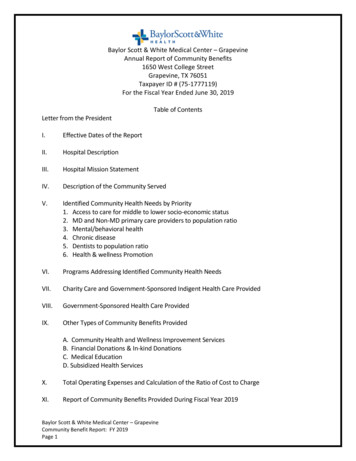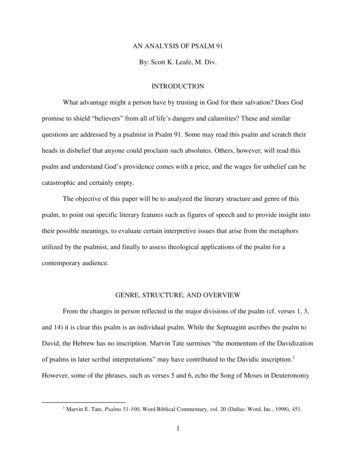
Transcription
AN ANALYSIS OF PSALM 91By: Scott K. Leafe, M. Div.INTRODUCTIONWhat advantage might a person have by trusting in God for their salvation? Does Godpromise to shield “believers” from all of life’s dangers and calamities? These and similarquestions are addressed by a psalmist in Psalm 91. Some may read this psalm and scratch theirheads in disbelief that anyone could proclaim such absolutes. Others, however, will read thispsalm and understand God’s providence comes with a price, and the wages for unbelief can becatastrophic and certainly empty.The objective of this paper will be to analyzed the literary structure and genre of thispsalm, to point out specific literary features such as figures of speech and to provide insight intotheir possible meanings, to evaluate certain interpretive issues that arise from the metaphorsutilized by the psalmist, and finally to assess theological applications of the psalm for acontemporary audience.GENRE, STRUCTURE, AND OVERVIEWFrom the changes in person reflected in the major divisions of the psalm (cf. verses 1, 3,and 14) it is clear this psalm is an individual psalm. While the Septuagint ascribes the psalm toDavid, the Hebrew has no inscription. Marvin Tate surmises “the momentum of the Davidizationof psalms in later scribal interpretations” may have contributed to the Davidic inscription.1However, some of the phrases, such as verses 5 and 6, echo the Song of Moses in Deuteronomy1Marvin E. Tate, Psalms 51-100, Word Biblical Commentary, vol. 20 (Dallas: Word, Inc., 1998), 451.1
232 (cf. Deut. 32:23-24). As such, Jewish tradition links Psalm 91 with Psalm 90 and concludesthe speaker is Moses. Nevertheless, whoever the actual anonymous speaker is some view thispsalm as a psalm of lament of the sick and anguished.2 Yet the typical structure of a lamentpsalm is not clearly evident in the three major sections of this psalm. More commonly this psalmis considered a psalm of trust and confidence, or protection and refuge.3Structurally the psalm has three main sections: verses 1-8, 9-13, and 14-16. The first twosections mirror each other with alternating themes of the speaker confessing Yahweh as refuge,Yahweh’s promise of protection, and the promise of the speaker’s security. The final section isan independent prophetic oracle of assurance on behalf of Yahweh back to faithful believers.Some, such as Tate, suspect this psalm was part of a much larger liturgy of worship for the kingdelivered by two priests. Yet he acknowledges others see this psalm as a liturgy for any believerin Yahweh.4 Of additional interest is the near verse by verse similarity with the words of Eliphazthe Temanite in describing the good man’s life in the Book of Job (cf. Job. 5: 17-23).5In some ways the structure of the psalm is peculiar; that is, an “antiphonal arrangement”is encountered where up to three speakers may actually be present.6 The first speaker is heardfrom in verses 1-2 and 5-8, while an apparent second speaker responds to the first in verses 3-42C. Hassell Bullock, Encountering the Book of Psalms : A Literary and Theological Introduction,Encountering Biblical Studies (Grand Rapids, Mich.: Baker Academic, 2001), 141-42.3Leopold Sabourin, The Psalms: Their Origin and Meaning, New, enl., updated ed. (Staten Island, N.Y.,:Alba House, 1974), 380. See also Joseph A. Alexander, Psalms Translated and Explained (Grand Rapids, Mich.:Baker Book House, 1975), 384. and Craig C. Broyles, Psalms, Understanding the Bible Commentary Series(Peabody, MA; Grand Rapids, MI: Hendrickson ; Baker Books, 1999), 361.4Tate, 452.5J. J. Stewart Perowne, The Book of Psalms (Grand Rapids, Mich.: Zondervan Pub. House, 1976), 172. Seealso Psalms, ed. H. D. M. Spence-Jones, The Pulpit Commentary, vol. II (London; New York: Funk & WagnallsCo., 1909), 267-68.6Psalms, 267.
3and 9-13. A third speaker appears to speak on behalf of Yahweh in verses 14-16.The subject of the psalm is the security of the individual that places their full trust andconfidence in God. To ensure the reader understands the depth and breadth of the refuge found intrusting in God, he portrays all manner of dangers and fears that would consume the commonman in life. In spite of these conditions the psalmist is resolute that his protection from Yahwehwill be complete and is assured. The psalm closes with God acknowledging the faithfulness ofthe speaker and promises him protection, rescue, and salvation over a long life.LITERARY FEATURESThe psalm begins with the first speaker recounting a kind of “motto” in verse 2 – “I willsay to the Lord, ‘My refuge and my fortress, My God, in whom I trust!’” This is not animperative; rather, this is an invitation for the reader to find their refuge in God by trusting inHim – it is an obligation if a believer is to experience God’s protection. The one trusting in Goddwells in the “protective shadow of the mighty king”7 The psalm then pivots to the secondspeaker who addresses the first speaker with a portrait of God’s protection in the face of gravedanger and fears. The metaphor of God’s protective wings is presented as shelter (v. 4) and maybe an allusion to the cherubim in the Jerusalem temple, but is also used elsewhere in a similarrefuge context as this psalm (cf. Ex. 19:4; Deut. 32:11; Psa. 5:12-13, 17:8, 64:8).8 God’sprotective wings serve as a protective shield to those who seek out God as their refuge fromdestructive forces.7The divine name used here is "Shaddai" (see also Psa. 68:14). According to the syntactical notes in theNew English Translation Bible, “Shaddai (or El Shaddai) is the mighty king (sovereign judge) of the world whogrants life/blesses and kills/judges. In Genesis he blesses the patriarchs with fertility and promises numerousdescendants. Outside Genesis he both blesses/protects and takes away life/happiness” (Biblical Studies Press., NetBible : New English Translation, 2nd Beta ed. (Spokane, Wash.: Biblical Studies Press, 2003), Psalm 91:1.).8Tate, 454.
4The dangers described by the first speaker could arise at any time, day or night (v. 5, 6).The dangers include the “snare of the trapper” and “deadly pestilence” (v. 3, 6) – perhapsallusions to all sorts of traps or threats from enemies and natural causes, but in any case alldangers of any kind. The dangers also include “terror by night” and the “arrow that flies by day”(v. 5). Certainly in the period of the psalmist, and in his ancient Near East context, there wasalways fear of disease and attack by an enemy commonly by night but also by day. Perhaps thelanguage of plague and disease (v. 3, 6) represents the consequences of sustained siege warfarewhere the city is cut off from the outside world with no food and even perhaps no water. Theshadow of the Almighty also protects against the “destruction that lays waste at noon” (v. 6; lit.“from ruin and the demon of the midday”) – a possible allusion to sunstroke (cf. Psa. 121:6).9Though thousands may fall in battle or as a consequence of natural catastrophes, believers inYahweh will not suffer anything themselves but will look upon the retribution of the wicked (v.8).The second speakers returns in verse 9 and confirms no harm or illness will come uponthe first speaker who has taken refuge in the Lord (v. 9-10). To help deliver the believer fromphysical dangers and to provide strength to overcome other difficulties in life – in this case moralstumbling blocks (v. 12) and also wild lions and snakes (v. 13; perhaps a cobra, see Psa. 58:4) –Yahweh will order his angels to protect him (cf. Heb. 1:14). The psalm closes with a thirdspeaker uttering a prophetic oracle on behalf of Jehovah (v. 14-16). God assures believers that hedoes deliver the faithful (v. 14), that he truly hears and answers their prayers (v. 15), that he will9Psalms, 268.
5be with them in times of trouble and will rescue them from peril, and will grant them longevityin life and the experience of salvation (cf. Psa. 50:23).10A particularly important literary feature of this psalm is Satan’s misapplication of verses11 and 12 at Jesus’ temptation (Matt. 4:6; Luke 4:10, 11). The psalmist is acknowledging God’sfatherly care over those who are trusting in him. The psalmist assures us that this protection is inevery way (v. 11b). When quoting verses 11 and 12 to Jesus, Satan omitted “in all your ways.”The psalmist seems to have taken for granted that “all your ways” are in accordance with God’swill and purpose. So Satan’s proposal that Jesus throw himself from the temple in no wayresembles the intention of the psalmist.11 Satan misapplied and distorted Scriptures to fit his ownagenda.INTERPRETIVE ISSUESThe metaphorical language employed by the psalmist provides much fruit for interpretivediscussions. Beginning with verse 3 and 4 the speaker announces delivery of the believer fromthe “snare of the trapper” and from the “deadly pestilence.” These metaphors are undefined, butTate concludes this language is representative of “all kinds of traps from enemies and fromnatural causes.”12 The pestilence of verses 3 and 6 may have implied serious illness. BruceReichenbach suggests that ancient Hebrews viewed serious illness as more than just a physicalissue. Instead, they viewed it in “spiritual and moral dimensions that made it appropriate to10Roger Ellsworth, Opening up Psalms (Leominster, England: Day One Publications, 2006), 41.11Don B. Garlington, "Jesus, the Unique Son of God: Tested and Faithful," Bibliotheca Sacra 151, no. 603(1994): 299.12Tate, 454. See also Psa. 124:7; Prov. 6:5.
6beseech the Almighty for deliverance.”13 Hence, the refuge provided by Yahweh had a muchbroader meaning for the psalmist than simply that no illnesses would befall him.Verses 5 and 6 serve up additional interpretive issues as the metaphors are equally vague.The commonality among each of the dangers is the completeness of time – they can occur at anytime of day or night. Tate suggests the round robin of day-night/fear-terror have parallels in otherplaces in Scriptures. For example, he finds unexpected attacks at night in Exod. 4:24-26; 11:4-5(the Angel of Death going forth at midnight so the firstborn of Egypt would die), and also Judg.7:19; 16:2-3; Obad. 5; Neh. 6:10. Similarly, midnight and noonday seem to have been times ofspecial anxiety to the ancient Hebrew world (see Exod. 11:4-5; 12:29-30; Ruth 8:9 for midnightanxiety; for noon time see Deut. 28:29, Jer. 6:4, Isa. 59:10, Amos 8:9). He sees specialsignificance in Jer. 15:8 as it references “destroyer at noonday.”14Some interpreters see all four of the dangers in verses 5 and 6 as expressions of demonsand/or evil spirits. For example, the “terror by night” finds a companion in the description ofZaqar, a god of dreams, in a Mesopotamian incantation of magic entitled, “the terror of thenight.”15 Sabourin also sees a possible demonic expression in verse 6, which is literally translated“the noonday devil” in the Vulgate, being influenced by the Oriental representation of pestilenceas a demon “especially active during the night and noon siesta.”16 That Satan should quote verse13Bruce R. Reichenbach, "By His Stripes We Are Healed," Journal of the Evangelical Theological Society41, no. 4 (1998): 553.14Tate, 454-55.15Ibid., 455.16Sabourin, 380.
711 and 12 at Jesus’ temptation may indicate the demonic world, his world, considered thepromises of this Psalm a specific threat.17Notwithstanding the apparent similar fears found elsewhere in Scripture, perhaps asimple all-encompassing approach would be more memorable here. For example, the “terror bynight” in verse 5 could be an allusion to thieves that come by night or by attacks by enemies thatcommonly occur at night. Perhaps the battle analogy fits best since verse 5b speaks of the arrowthat flies by day. Thus a battle scene is painted and the man of God will be given specialprotection by God from the perils of battle. Yet an even broader brush is provided by Tate whoalso finds “the appearance of a merism” in these metaphors; that is, “dangers may occur at anytime, day or night – a comprehensive statement of the perils of life.”18A further interpretive issue can be found in verse 7. The sheer number of fallen, onethousand at the believer’s side and ten thousand at his right hand could lead a reader to see all ofverses 5 and 6 as that of battle scenes. For example, A. R. Johnson sees all of verses 5 and 6 asthe culmination and consequences of war: surprise attacks at night, shots from bows by day, thedeath and disease that accompany siege and thousands of corpses, and the believer seeing all ofthe fallen while remaining unscathed because of God’s shielding power.19 Yet the metaphoricallanguage of seems too unspecific and the comprehensive battle analogy seems to stretch theauthorial intent. Perhaps the best understanding of verse 7 is simply that many, many peopleperish for some unspecified reason but whatever the reason the faithful of God are unharmedwitnesses to the event.17Elmer B. Smick, "Mythpoetic Language in the Psalms," Westminster Theological Journal 44, no. 1(1982): 94.1819Tate, 454.Aubrey R. Johnson, The Cultic Prophet and Israel's Psalmody (Cardiff: University of Wales Press,1979), 188-89.
8THEOLOGICAL IMPLICATIONS AND APPLICATIONBroyles comments this psalm provides many believers with some of the most comfortingpromises of the Bible. But he also acknowledges the many others see these promises as the mostunrealistic.20 That is, the psalmist is portraying evil and danger and disease from which God willalways deliver a believer if he/she fully trusts God for his/her protection. Yet the reality is thatbelievers in God do experience suffering and/or death at the hands of disease and humanenemies. So the question arises what was the psalmist really trying to communicate to hisreaders?Several features of this psalm become very important when attempting to understand allthe psalmist was proclaiming. First, in verse 15 Yahweh concedes that a believer may be in lifesituations that are counted as trouble – fearful and even dangerous situations. Therefore, inverses 14-16 God promises to be with the believer in times of trouble, to rescue him andultimately show him salvation. The point is this, most of the time God does keep believers fromcalamity. John Calvin once wrote,When we look back on our life from the perspective of eternity, we are going to see thatthe power of Satan was so great, that the weakness of our flesh was feeble, and that thehostility of the world was so strong, that every day of our lives – if God had notintervened – we would never have made it through a day.21Second, when verse 8 is closely examined, the punishment of the wicked comes clearlyinto view. Thus, the believer is never promised that no calamities will befall them in this life;rather, believers are exempt from divine retribution.22 Sometimes God does allow calamities to20Broyles, 362.21Cited by Joel C. Gregory, Growing Pains of the Soul (Waco, Tex.: Word Books, 1987), 66.22Broyles, 362.
9come upon believers for their own good. But when he does allow such things to happen, he isalways there to strengthen them and helps them bear it.23Third, Broyles sees a similar theme in Psalm 91 with that of psalms of temple entrywhere the righteous are granted refuge with God but the wicked may never enter into any portionof God’s realm of protection.24 For contemporary readers, this provides a warning that God’sprotection only comes upon those who are trusting in him. There is no provision for refuge inGod outside of fully trusting in him for salvation.CONCLUSIONPsalm 91 may at first blush be confusing to some as the promises to believers seem out ofreach of reality. However, God’s promises of refuge to those who are trusting in him includedeliverance from divine retribution reserved for the wicked. The psalmist is not attempting toportray a care-free life void of calamity; rather, he is portraying a confidence in God’s promisesto deliver believers from calamities in accordance with his sovereign will. The qualities of agodly life can ultimately yield a longer life and one that includes much more satisfaction.The objective of this paper was to analyze the structure, literary form, interpretativechallenges, and to provide a theological summary and contemporary application of the thematicelements of the psalm. The psalm is a psalm of trust and confidence in the refuge provided tobelievers by God in the face of any and all of life’s calamities. While all the promises providedin this psalm may seem to fall a bit short in practice and the reality of life, they will be perfectlyand fully fulfilled at the appearing of Christ Jesus in glory.23Ellsworth, 40-41.24Broyles, 362.
10BIBLIOGRAPHYAlexander, Joseph A. Psalms Translated and Explained. Grand Rapids, Mich.: Baker BookHouse, 1975.Biblical Studies Press. Net Bible : New English Translation. 2nd Beta ed. Spokane, Wash.:Biblical Studies Press, 2003.Broyles, Craig C. Psalms Understanding the Bible Commentary Series. Peabody, MA; GrandRapids, MI: Hendrickson ; Baker Books, 1999.Bullock, C. Hassell. Encountering the Book of Psalms : A Literary and Theological IntroductionEncountering Biblical Studies. Grand Rapids, Mich.: Baker Academic, 2001.Ellsworth, Roger. Opening up Psalms. Leominster, England: Day One Publications, 2006.Garlington, Don B. "Jesus, the Unique Son of God: Tested and Faithful." Bibliotheca Sacra 151,no. 603 (1994): 284-308.Gregory, Joel C. Growing Pains of the Soul. Waco, Tex.: Word Books, 1987.Johnson, Aubrey R. The Cultic Prophet and Israel's Psalmody. Cardiff: University of WalesPress, 1979.Kidner, Derek. Psalms 73-150 : A Commentary on Books Iii-V of the Psalms The Tyndale OldTestament Commentaries. London: Inter-Varsity Press, 1975.Perowne, J. J. Stewart. The Book of Psalms. Grand Rapids, Mich.: Zondervan Pub. House, 1976.Psalms. Vol. II The Pulpit Commentary, Edited by H. D. M. Spence-Jones. London; New York:Funk & Wagnalls Co., 1909.Reichenbach, Bruce R. "By His Stripes We Are Healed." Journal of the Evangelical TheologicalSociety 41, no. 4 (1998): 551-560.Sabourin, Leopold. The Psalms: Their Origin and Meaning. New, enl., updated ed. Staten Island,N.Y.,: Alba House, 1974.Smick, Elmer B. "Mythpoetic Language in the Psalms." Westminster Theological Journal 44, no.1 (1982): 88-98.Tate, Marvin E. Psalms 51-100. Vol. 20 Word Biblical Commentary. Dallas: Word, Inc., 1998.
Marvin Tate surmises "the momentum of the Davidization of psalms in later scribal interpretations" may have contributed to the Davidic inscription.1 However, some of the phrases, such as verses 5 and 6, echo the Song of Moses in Deuteronomy 1 Marvin E. Tate, Psalms 51-100, Word Biblical Commentary, vol. 20 (Dallas: Word, Inc., 1998), 451.
